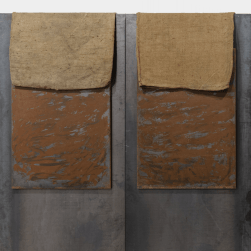
Jannis Kounellis
Presented by Sprovieri Gallery London
At Ambika P3, University of Westminster, London
23 April – 30 May 2010
Greco-Italian artist Jannis Kounellis, a key figure in international contemporary art for over forty years, will create major new works, especially conceived for Ambika P3. Using the unique characteristics offered by the spaces of Ambika P3 as his canvas, this major new exhibition, presented by Sprovieri Gallery, will be the first solo presentation by Kounellis in a public London space since the Whitechapel Art Gallery exhibition in 1982.
Jannis Kounellis was initially associated with the Italian Arte Povera of the late 1960s, a movement that tried to free art from the conventions, structures and the market place restrictions of the day, and also (through the nature of the materials used) to make an art much closer to the everyday life of people. In 1969 he was made famous by a work he presented in Rome in which he temporarily turned a gallery into a stable for twelve horses. Since then, through his continued pushing of the boundaries of what is considered art, Kounellis has remained at the forefront of developments in contemporary art.
While his works are perhaps best known for their frequently epic scale, it is in the details of their making that they are at their most human. Always made from a gathering of everyday materials (such as wool, sacking, used clothing, old musical instruments or pieces of steel), when grouped together these disparate ingredients take on new meanings and associations. In one famous untitled work from 1967, Kounellis cut a sheet of steel into the shape of a flower, and inserted a gas flame at its centre – the hard, metallic cold of the steel contrasting with the form of the inanimate flower, which in turn gave forth a hot, (life and death giving) lick of fire. In another piece from 2004, installed in a space filled with oriental carpets and covered by an army of falling steel crosses suggesting the encounter of two different cultures, he again contrasted the textures, strengths and uses of the materials, while reconnecting them to man through their histories.
Starting his career as a painter, Kounellis still describes his practice as painting. His first paintings were exactly the size of one of the walls in his house. Physical space then became his canvas and in this respect the actual making of his works also becomes something of a performance, in which the space is articulated by the placing of the objects within it. It is no surprise therefore that Kounellis works only within carefully selected spaces.







